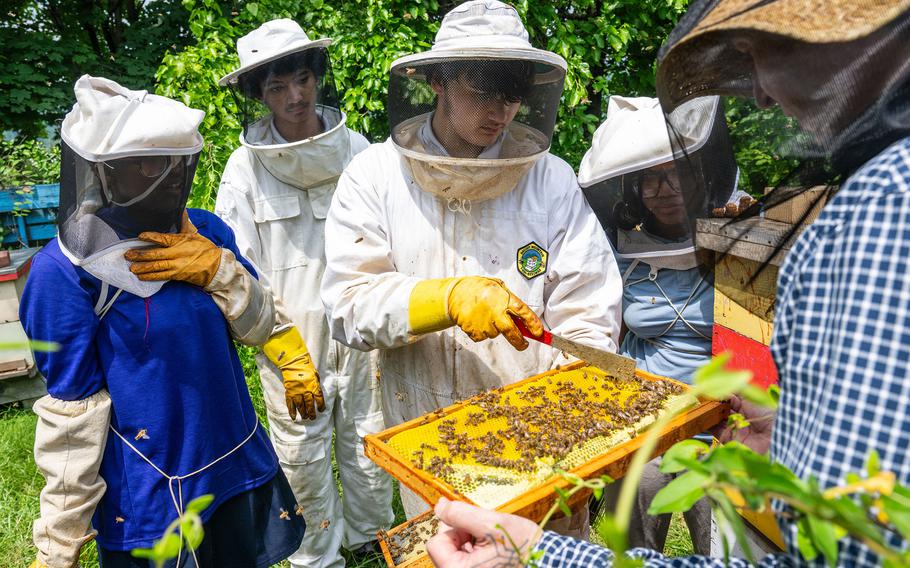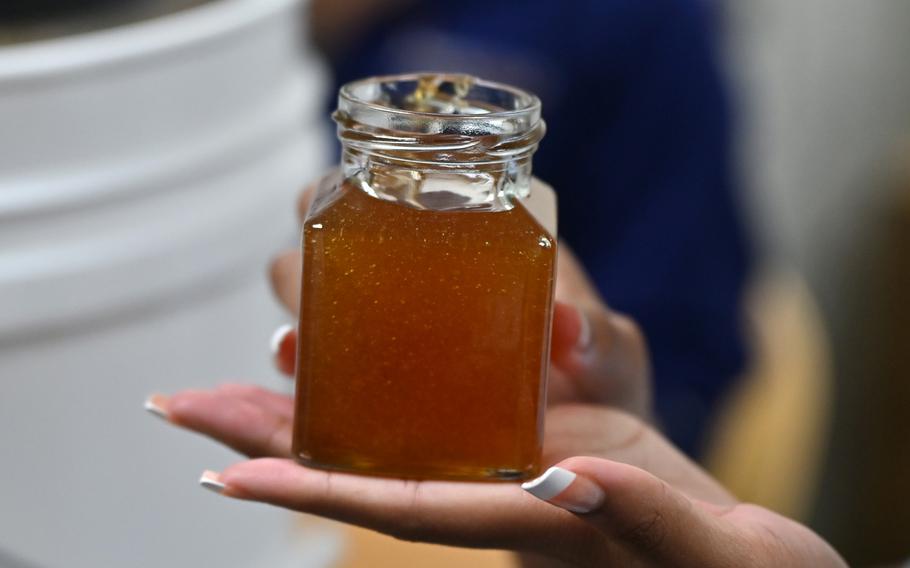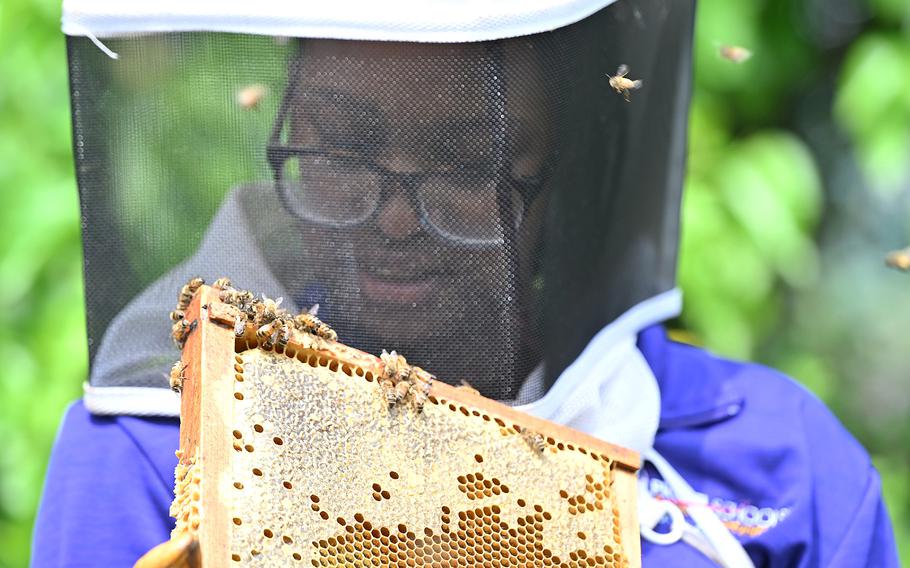
Propel Andrew Street students, from left, Promiss McCarrell, Drew Demko, Ryan Snyder and Kimony Harris help their teacher, Brandon Keat, right, check on some bees they keep in Homestead, Pa., on June 9. They are part of a semester-long elective beekeeping class. (Lucy Schaly, Pittsburgh Post-Gazette/TNS)
PITTSBURGH — Drew Demko’s hands are steady as he grabs a wooden hive frame covered in beeswax, and places it into an awaiting pail at Propel Andrew Street High School in Munhall, Pa.
Using a “hot knife” — beekeeper lingo for a heated brisket knife designed for slicing — he gently cuts away the white wax caps that cover the honey collected on honeycombs.
Uncapping, as the process is called, is sticky, messy work. So the floor of the teacher’s lounge where Demko and his classmates are working on a recent Thursday is covered in a sheet of blue plastic.
Nevertheless, it’s a rewarding on-hands learning experience for the 15-year-old high school freshman, who before getting placed in the class “by chance” had only occasionally tasted the sweet and viscous liquid made by bees, and preferred gaming to doing “stuff with his hands.”
In addition to learning how to check a beehive for mites and other problems, the Clairton teenager has gained a pretty good understanding of “the stuff beekeepers go through,” he says — if the worker bees are making honey, for example, or if the queen is still laying eggs or the hive has been requeened.
And, no, unlike most students who take the class, he hasn’t been stung yet despite being in close contact with what English teacher Brando Keat estimates to be an apiary of more than 200,000 honey bees. (Parents/guardians sign a waiver that warns them participants may be stung and relieves the school of liability.)
“I’m not afraid of bees,” Drew declares as he scrapes the honeycombs.
There are eight hives on the vacant corner lot on East 11th Avenue in Munhall. Three of the hives are deemed “mature” by Keat, who started the school’s beekeeping program in 2009, almost on a whim. Three more are “nucs,” or small nucleus colonies created from larger colonies. The final two were captured from swarms and transported to new digs alongside the others.
Drew might claim to be inexperienced when it comes to working with his hands, “but he quickly became very adept,” Keat says. The same can be said for the five other kids in the semester-long elective class, offered twice a year, that in 2013 received a Governor’s Award for Environmental Excellence.
Some enjoy learning about the life cycle of bees and how honey is made enough that they take the class multiple times. One former student started a beekeeping club at Westmoreland County Community College.
“And a few others have started their own hives” as a way to earn extra income, Keat says.

Kimony Harris displays some of the finished honey she and classmates harvested from hives in Munhall. Students harvest their honey three times a year: in spring, early July and in October. Sales totaling about $3,000 a year have kept the beekeeping program financially self-sustaining since it began. Along with bottling the honey into 6 1/2 -ounce jars that sell for $5 each, students also make body butter ($5) and tubes of lip balm (two for $5) by mixing the beeswax with shea butter, coconut oil and essential oils like peppermint. (Lucy Schaly, Pittsburgh Post-Gazette/TNS)
A slow, sweet start
Keat, who teaches creative writing along with psychology and financial literacy, came up with the idea for the apiary in 2009, shortly after he started teaching at the school.
In his previous career as a reporter covering police and courts for a local paper, he happened to do a story on a beekeeper in Marshall who was being shut down because officials said his lot was too small for agricultural use. Having always been interested in ecology, he found the practice of beekeeping “so pleasant to me. But I had no plans to become a beekeeper.”
Instead, the impetus for the class came when former student Jonathan Walker, who wanted to be an entomologist, asked if the school could find the resources to start a beekeeping club.
Keat took the idea to Propel co-founder and then-superintendent Carol Wooten, who agreed it was a great idea after ironing out the details. Growing enthusiasm helped turn the club quickly from an extracurricular activity into an elective class in April 2010.
Keat and his students started with two hive “packages” housing around 40,000 bees from Country Barn Farm in O’Hara. They were placed in a sunny patch behind the former St. Michael Parish convent on Braddock Avenue that was owned by then-Braddock mayor John Fetterman. It had previously been used by Burgh Bees, a nonprofit organized in 2006 to promote urban beekeeping.
Then, they set about learning the art of beekeeping, drawing from books and documentaries. Local beekeepers Robert Steffes and Joe Zgurzynski also offered guidance, Keat said, along with others in the Burgh Bees community.
“It was something unique,” he says. “You get an understanding of science in the natural world in a real-life way ... and it’s not as scary as you think.”
In 2017, the hives were moved to their current location on East 11th Avenue (where Munhall High School once stood), after a donor purchased the site to allow the program more space and put it within easy walking distance of the school.
Since he knew almost nothing about beekeeping back then, Keat learned the ins and outs of managing an apiary alongside his students. Lessons included basics like how bees forage from flowers to collect nectar, break it down into sugar and store it in a honeycomb, and more specifically, how to manage a hive without pesticides and safely gather the honey for processing.
Because students market and sell what they gather and extract from the frames, the class — limited to a half-dozen students each semester — is able to incorporate entrepreneurship and community service into learning along with biology, math and science.
Working and learning alongside his students is the “ultimate teaching style,” Keat notes.
Students harvest their honey three times a year: in spring, early July and in October. Sales totaling about $3,000 a year have kept the beekeeping program financially self-sustaining since it began. Along with bottling the honey into 6 1/2 -ounce jars that sell for $5 each, students also make body butter ($5) and tubes of lip balm (two for $5) by mixing the beeswax with shea butter, coconut oil and essential oils like peppermint.
Much of it is sold via a built-in network of Propel families, teachers and former students, but the students’ product has also made the occasional appearance at The Farmer’s Daughter Flowers on the North Side and Braddock Farm Stand in Braddock.

Promiss McCarrell examines a tray of bees at Propel Andrew Street High School in Munhall. (Lucy Schaly, Pittsburgh Post-Gazette/TNS)
The buzz keeps growing
Beekeeping as a recreational and hobbyist activity has been on the rise in recent years, including in urban areas. That’s due in part to a growing understanding that bees are essential players in our food systems and the ease of starting a backyard hive.
The National Honey Board says the vast majority of the estimated 125,000 beekeepers in the U.S. are hobbyists with fewer than 25 hives. In Pennsylvania alone, there are 5,300 registered beekeepers, according to the Pennsylvania State Beekeepers’ Association. And more backyard hives arise each year.
That said, beekeeping programs are still unique in secondary education. As far as Keat knows, Propel is something of an outlier in Pennsylvania.
“I have never heard from another school — anywhere — that has a program like this,” he says. “People from several school districts all across the country have reached out to me in past years to get advice, but as far as I know none of them have successfully launched their own high school beekeeping programs, or operates on the level we do.”
Now in its 16th year, the class is still incredibly popular, even if some kids come into it with a fear of being stung.
“But 90% get over it,” he says.
Kimony Harris, 18, is a “ringer” who took the class for the second time this year.
“I like how small and comfortable the class is,” she says, “and the trips to the beehive are fun.”
“It’s more involved” than regular coursework, agrees 10th-grader Ryan Snyder, 16, who signed up for the class for the first time this spring.
Due to its built-in fear factor, beekeeping doesn’t always click on the first go: Ke’naia Wright dropped the class last year pretty quickly when she decided “it’s not for me.” But the 17-year-old returned this semester “because I wanted to face my fears.”
She adds that Keat “is cool and he knows what he’s talking about. He’s very passionate.”
Back in the classroom, Keat quietly watches as Drew places the honeycombs he’s scraped free of wax into an extractor, where they are spun. As the machine spins and shakes over the next 15 minutes, the honey is flung out of the honeycomb cells, hits the side of the metal container and drains down. It’s then strained into a bucket to remove any tiny bees parts or bits of wax, after which students carefully pour it into jars.
He also observes as they determine whether the honey is “ripe” by checking its water content on a refractometer.
“If there’s too much, it’s not good,” he says.
Then the honeycomb is put back in the hive to further cure, the bees fanning it with their wings. Keat also keeps a careful eye on Ryan, who is washing the honey out of the leftover wax caps to make “meatballs” that will be wrapped in cheesecloth and boiled to remove impurities. The clean leftover beeswax can then be turned into lip balm and other products.
Depending on how full they are, 30 frames produce anywhere from 120-150 jars of honey, Keat says. Spring and summer honey are a bit thinner than fall honey because the bees gather a different kind of nectar, which affects its viscosity.
Thanks to its low pH and high sugar content, honey has antiseptic properties, Keat notes. As long as the lid stays on, honey with a moisture content of 18% or less can be stored indefinitely, which makes it a great ingredient in the kitchen and pantry.
Rich in antioxidants and full of natural sweetness and flavor, honey can be used as a substitute for sugar in everything from baked goods and glazes for various proteins to marinades and sauces.
While Keat appreciates the acknowledgement of the 2013 state award, it’s watching how working with bees changes students’ lives and helps them confront their fears that keeps him going year after year.
As he reminds his students during the semester-long course, “you’re not in a beekeeping class. You’re a beekeeper.”